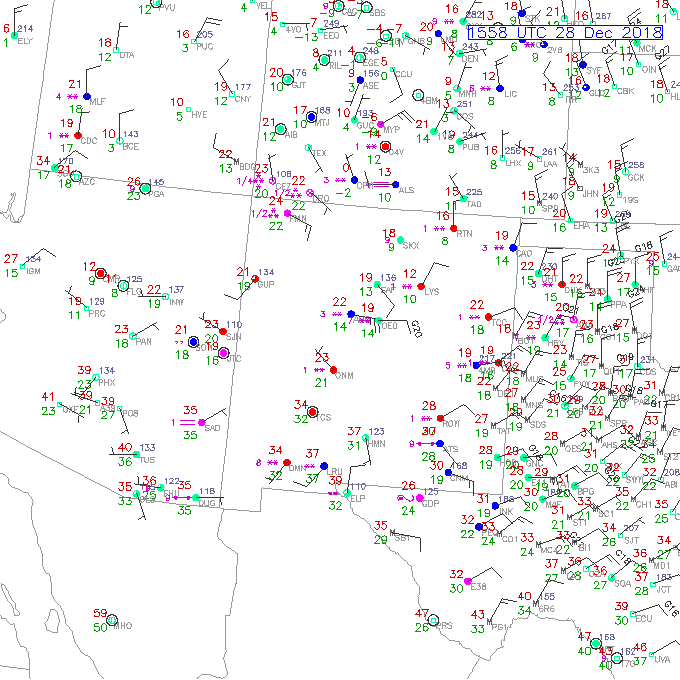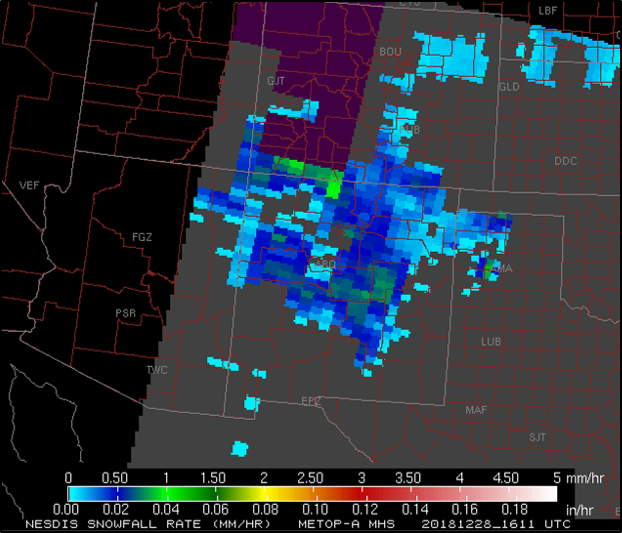New Mexico Snowstorm
Due to an upper-level disturbance passing through the southwestern United States, abundant snowfall has fallen in New Mexico, southwestern Colorado and parts of Texas (see social media snowfall image here). Snow totals range from a few inches to 16 inches at higher elevations. Snowfall has been observed via surface observations and by satellite this morning, 28 December 2018 at ~16Z. Surface observations and satellite images are offset by ~13 minutes.
RAP Real-Time Weather Data – Surface Observations @ 1558Z, 28 December 2018.
Snowfall is observed (i.e. weather station plots displaying purple, asterisk symbols) in parts of New Mexico, Texas, and southwestern Colorado. Multiple asterisks imply heavier snow rates observed by site. Notice, large areas of New Mexico, that do not have surface observations; this is where satellite and radar data are helpful in observing snowfall rates in ‘surface data’- sparse regions.

NESDIS Snowfall Rate Product (NASA-SPoRT) – Snowfall Rate Product @ 1611Z, 28 December 2018.
The NESDIS Snowfall Rate Product utilizes microwave snowfall rate data derived from polar-orbiting satellites (e.g. S-NPP, MetOp, DMSP; note more polar-orbiters are implemented into the algorithm). Snowfall rate is shown in ‘liquid equivalent’, displayed in inches per hour, and millimeters per hour. Product utility is in observing snowfall rates in data-sparse regions, and identifying areas of heaviest snow. The image below, highlights the snowfall rate product at approximately 13 minutes after surface observations were observed. Snowfall rate product imagery indicates a widespread distribution of snowfall rates in New Mexico, and the surrounding states, where areas of heaviest snow are indicated in southwestern Colorado, central New Mexico and northern Texas. Maximum values range from 1-1.5 mm/hr or 0.04-0.06 inches/hour.

COD Weather – Radar Imagery @ 1610Z, 28 December 2018.
Collocated in time with satellite observations, the Albuquerque, NM radar imagery, shows regions of precipitation (green-to-yellow colors), in this case, areas of snowfall. However, take note that Albuquerque, NM is at high elevation (i.e. ~5300 feet) and is surrounded by high terrain. The Albuquerque, NM radar will interact with mountain ranges that may produce anomalous features (e.g. high dBZ values in an areas where it is not snowing). Radar coverage can also be poor in some areas, due to high terrain blocking radar signals, obscuring ambient atmospheric features.

More snowfall is expected for Albuquerque, NM for the next 24 hours.
